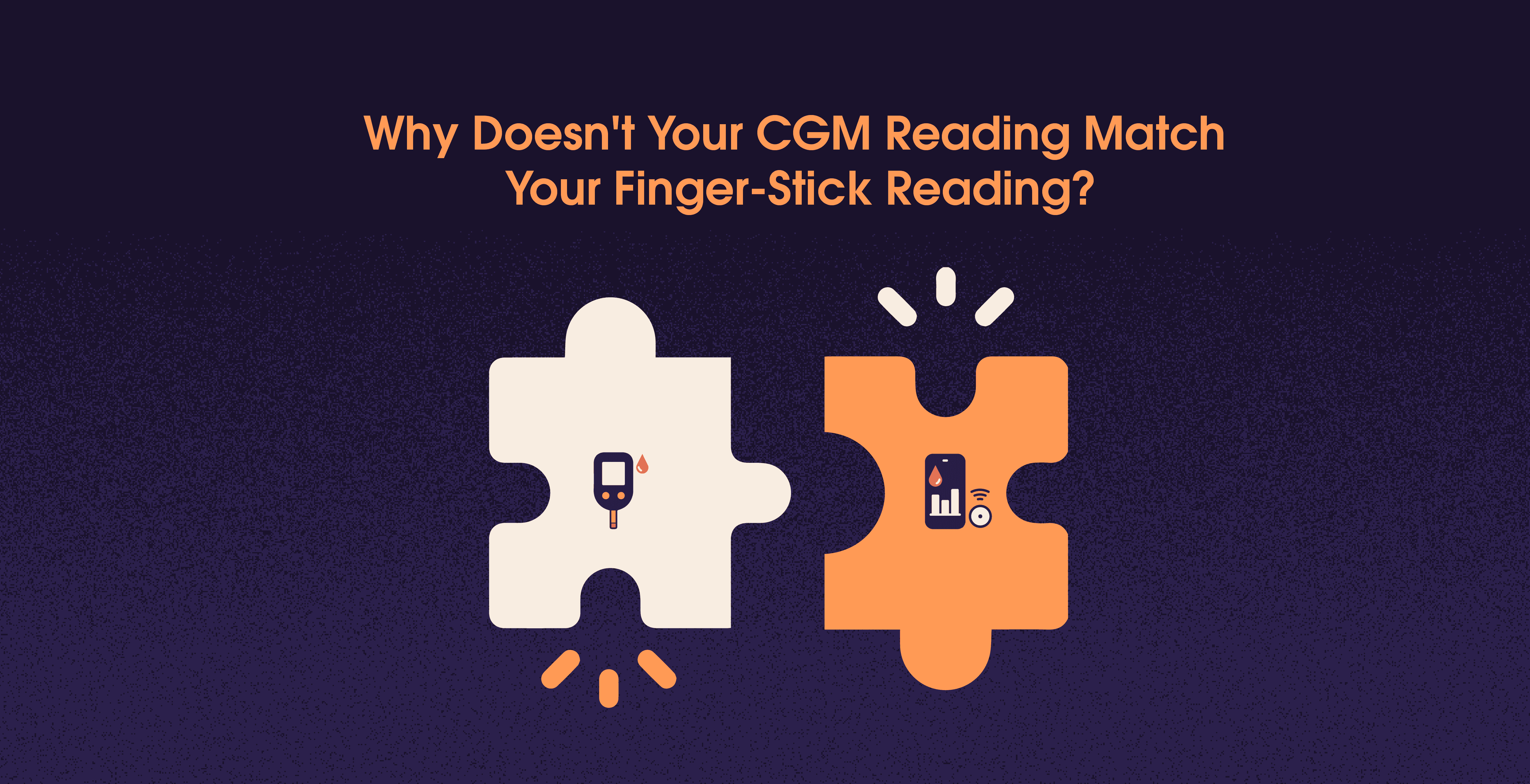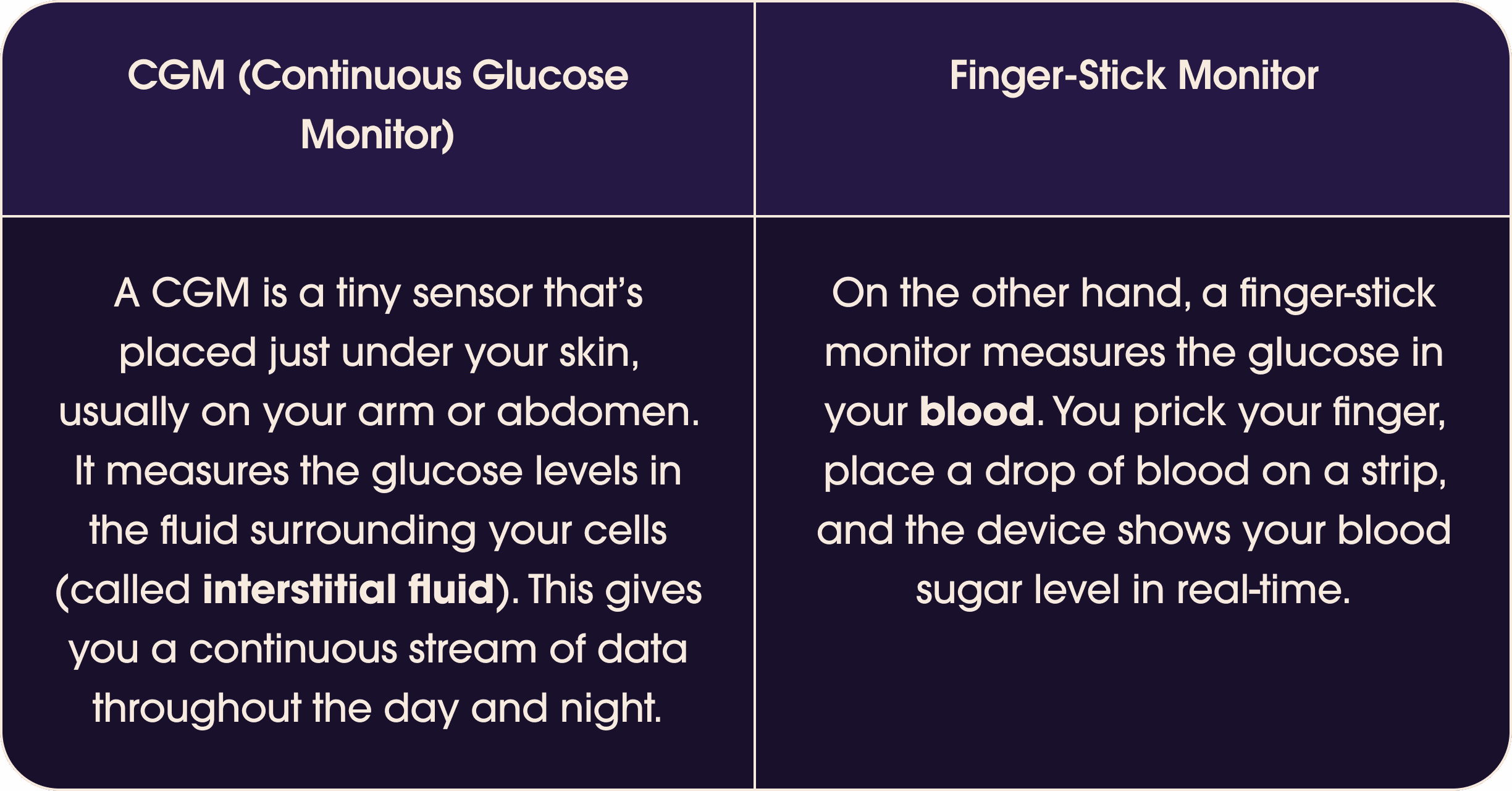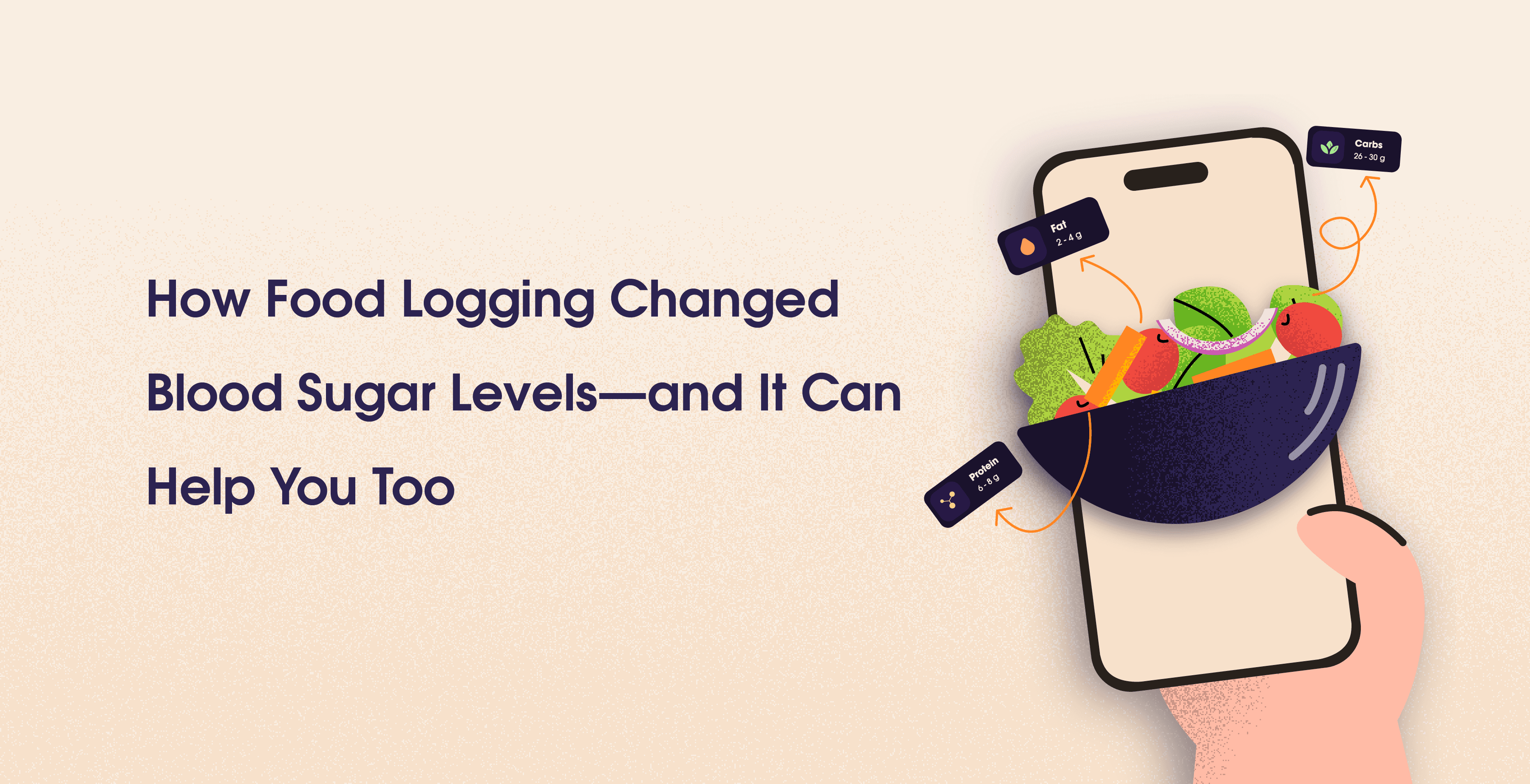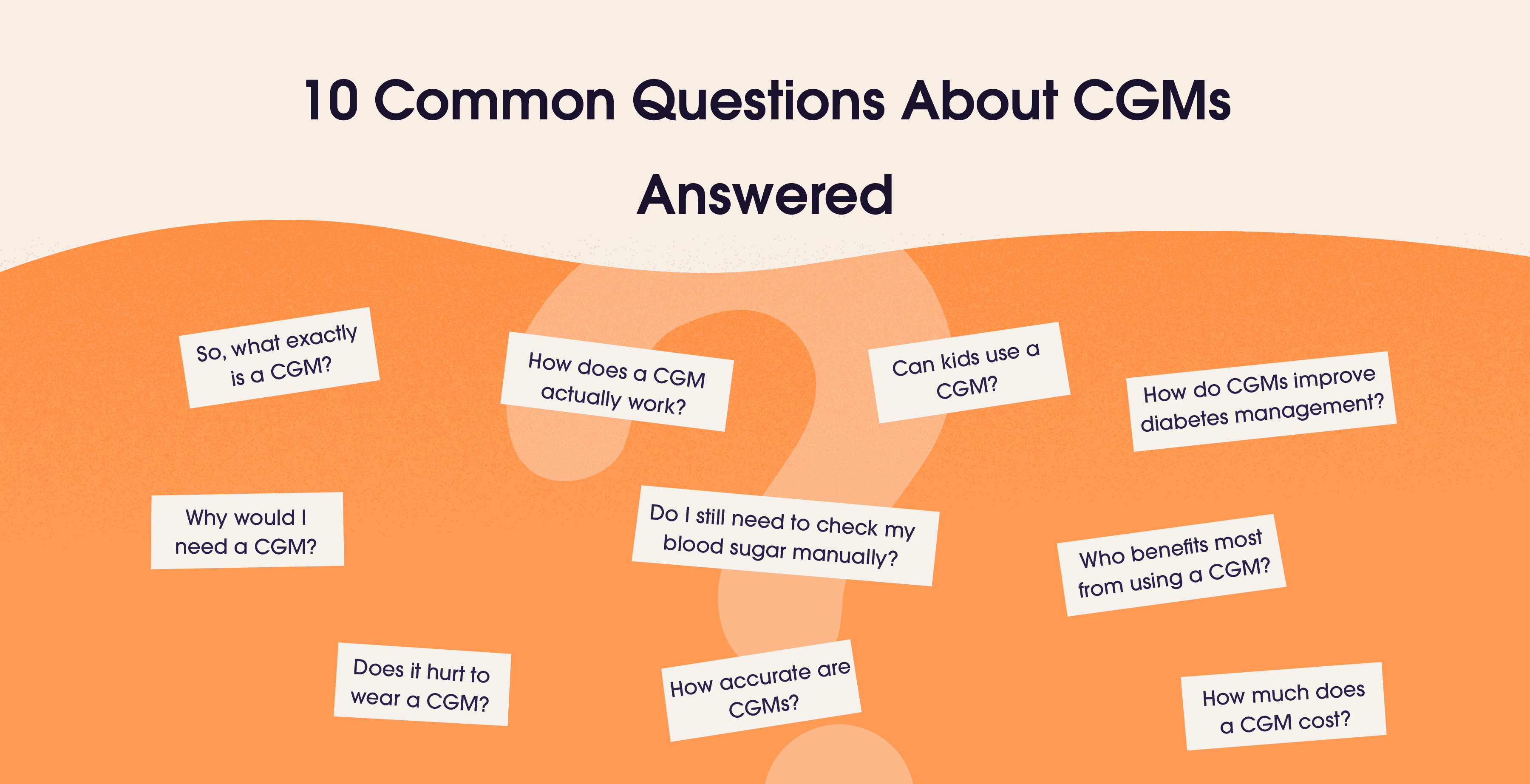Why Doesn’t Your CGM Reading Match Your Finger-Stick Reading?
Oct 4, 2024
Sayfali Rawlani



Table Of Contents
If you're using a Continuous Glucose Monitor (CGM) and comparing its readings to your traditional finger-stick monitor, you might have noticed they don’t always match up. This can be puzzling and might leave you wondering why. Don’t worry, this is completely normal and there are a few reasons behind it.
Let’s take a closer look at what’s going on when your CGM and finger-stick readings don’t see eye to eye.
Highlights
CGM measures glucose from interstitial fluid, while finger-stick measures glucose directly from blood, causing natural differences in readings.
There’s a 5-15 minute delay in CGM readings compared to finger-stick because interstitial fluid lags behind blood glucose changes.
Some CGMs need calibration using finger-stick readings. Even without calibration, CGMs have a 10-15% margin of error, which is normal.
Rapid spikes or drops in blood sugar, like after eating or exercising, can cause differences in CGM and finger-stick readings due to the delay in CGM's fluid measurement.
Proper sensor placement and lifespan affect CGM accuracy. Sensors typically last 7-14 days.
CGMs and Finger-Sticks: How They’re Different
Before we dive into the reasons, it’s important to understand the difference in how these two devices work.

Since these two devices measure glucose from different parts of your body (blood vs. interstitial fluid), it’s expected that the readings will sometimes be a little different.
Reasons Why CGM and Finger-Sticks Have Different Results
The “Time Lag” Explanation
One of the main reasons why the CGM and finger-stick readings don’t always match is because of a natural delay—better known as a “time lag.” The glucose levels in your blood change more quickly than they do in interstitial fluid. This means if your blood sugar is rising or falling fast (like after you eat or exercise), your CGM may show a delayed reading compared to your finger-stick.
To put it in simpler terms, your CGM is like watching a replay of the game, while your finger-stick gives you the live scores. There’s a bit of a lag, typically around 5-15 minutes, which is completely normal. So, if you’re seeing different numbers, especially during times when your blood sugar is changing quickly, it’s likely just because of this time lag.
CGM Calibration and Accuracy
CGM accuracy can also be influenced by whether your device is calibrated correctly. Some CGMs require manual calibration using a finger-stick reading. If your CGM isn’t calibrated properly, its readings might drift a little off-course.
Even CGMs that don’t require calibration can have a small margin of error. Most CGMs are considered accurate if they’re within 10-15% of your actual blood glucose level. So, even if the numbers aren’t identical, as long as they’re close, the CGM is doing its job.
Rapid Changes in Blood Sugar
Another factor to keep in mind is that blood sugar can change pretty quickly. For example, if you’ve just had a meal, your blood sugar may rise sharply, and your finger-stick monitor will capture that increase immediately. However, because CGMs measure interstitial fluid, they might show a lower reading until the glucose has fully made its way into the fluid.
The same thing can happen if your blood sugar is dropping, maybe after a workout or if you’ve taken insulin. Your finger-stick might show a low reading, while your CGM is still playing catch-up.
Sensor Placement and Issues
Where you place your CGM sensor can also affect its readings. The upper arm or abdomen tends to work best, but if the sensor isn’t in a good spot, or if it’s nearing the end of its life (most sensors last between 7-14 days), you might notice some discrepancies.
If your sensor has been on for a while and you’re noticing larger-than-usual differences in the readings, it could be time to switch to a new sensor.
What Should You Do When the Numbers Don’t Match?
If you see that your CGM reading and finger-stick reading are quite different, don’t panic. Here are a few tips on how to handle it:
Focus on Trends
Rather than fixating on the exact numbers, look at the overall trend. Is your glucose going up, down, or staying stable? The trend can tell you more about what’s happening with your blood sugar than a single reading.
Recalibrate if Necessary
If your CGM allows for calibration, check your finger-stick reading and recalibrate your CGM if needed. This might help get the readings closer in line.
Use Finger-Stick for Key Decisions
If you’re unsure, always rely on your finger-stick reading when making important decisions, like adjusting your insulin or eating carbs to correct a low. The finger stick provides a more immediate and accurate reading of your blood glucose level at that exact moment.
Consult Your Doctor
If you’re consistently seeing big differences between the two readings, it’s a good idea to talk to your doctor or diabetes educator. They can help you troubleshoot and make sure everything is working as it should.
Wrapping Up!
It’s normal to see differences between your CGM and finger-stick readings. This happens because the devices measure glucose from different parts of your body, and there’s a slight time lag in how quickly glucose moves from your blood into the fluid that your CGM is measuring. As long as the numbers are reasonably close and you’re focusing on trends, your CGM is still giving you valuable insights into your blood sugar patterns.
The key is not to stress about exact matches and remember that these tools are designed to work together to help you manage your health.
P.S If you would like to know more about your CGM - check this out
References
If you're using a Continuous Glucose Monitor (CGM) and comparing its readings to your traditional finger-stick monitor, you might have noticed they don’t always match up. This can be puzzling and might leave you wondering why. Don’t worry, this is completely normal and there are a few reasons behind it.
Let’s take a closer look at what’s going on when your CGM and finger-stick readings don’t see eye to eye.
Highlights
CGM measures glucose from interstitial fluid, while finger-stick measures glucose directly from blood, causing natural differences in readings.
There’s a 5-15 minute delay in CGM readings compared to finger-stick because interstitial fluid lags behind blood glucose changes.
Some CGMs need calibration using finger-stick readings. Even without calibration, CGMs have a 10-15% margin of error, which is normal.
Rapid spikes or drops in blood sugar, like after eating or exercising, can cause differences in CGM and finger-stick readings due to the delay in CGM's fluid measurement.
Proper sensor placement and lifespan affect CGM accuracy. Sensors typically last 7-14 days.
CGMs and Finger-Sticks: How They’re Different
Before we dive into the reasons, it’s important to understand the difference in how these two devices work.

Since these two devices measure glucose from different parts of your body (blood vs. interstitial fluid), it’s expected that the readings will sometimes be a little different.
Reasons Why CGM and Finger-Sticks Have Different Results
The “Time Lag” Explanation
One of the main reasons why the CGM and finger-stick readings don’t always match is because of a natural delay—better known as a “time lag.” The glucose levels in your blood change more quickly than they do in interstitial fluid. This means if your blood sugar is rising or falling fast (like after you eat or exercise), your CGM may show a delayed reading compared to your finger-stick.
To put it in simpler terms, your CGM is like watching a replay of the game, while your finger-stick gives you the live scores. There’s a bit of a lag, typically around 5-15 minutes, which is completely normal. So, if you’re seeing different numbers, especially during times when your blood sugar is changing quickly, it’s likely just because of this time lag.
CGM Calibration and Accuracy
CGM accuracy can also be influenced by whether your device is calibrated correctly. Some CGMs require manual calibration using a finger-stick reading. If your CGM isn’t calibrated properly, its readings might drift a little off-course.
Even CGMs that don’t require calibration can have a small margin of error. Most CGMs are considered accurate if they’re within 10-15% of your actual blood glucose level. So, even if the numbers aren’t identical, as long as they’re close, the CGM is doing its job.
Rapid Changes in Blood Sugar
Another factor to keep in mind is that blood sugar can change pretty quickly. For example, if you’ve just had a meal, your blood sugar may rise sharply, and your finger-stick monitor will capture that increase immediately. However, because CGMs measure interstitial fluid, they might show a lower reading until the glucose has fully made its way into the fluid.
The same thing can happen if your blood sugar is dropping, maybe after a workout or if you’ve taken insulin. Your finger-stick might show a low reading, while your CGM is still playing catch-up.
Sensor Placement and Issues
Where you place your CGM sensor can also affect its readings. The upper arm or abdomen tends to work best, but if the sensor isn’t in a good spot, or if it’s nearing the end of its life (most sensors last between 7-14 days), you might notice some discrepancies.
If your sensor has been on for a while and you’re noticing larger-than-usual differences in the readings, it could be time to switch to a new sensor.
What Should You Do When the Numbers Don’t Match?
If you see that your CGM reading and finger-stick reading are quite different, don’t panic. Here are a few tips on how to handle it:
Focus on Trends
Rather than fixating on the exact numbers, look at the overall trend. Is your glucose going up, down, or staying stable? The trend can tell you more about what’s happening with your blood sugar than a single reading.
Recalibrate if Necessary
If your CGM allows for calibration, check your finger-stick reading and recalibrate your CGM if needed. This might help get the readings closer in line.
Use Finger-Stick for Key Decisions
If you’re unsure, always rely on your finger-stick reading when making important decisions, like adjusting your insulin or eating carbs to correct a low. The finger stick provides a more immediate and accurate reading of your blood glucose level at that exact moment.
Consult Your Doctor
If you’re consistently seeing big differences between the two readings, it’s a good idea to talk to your doctor or diabetes educator. They can help you troubleshoot and make sure everything is working as it should.
Wrapping Up!
It’s normal to see differences between your CGM and finger-stick readings. This happens because the devices measure glucose from different parts of your body, and there’s a slight time lag in how quickly glucose moves from your blood into the fluid that your CGM is measuring. As long as the numbers are reasonably close and you’re focusing on trends, your CGM is still giving you valuable insights into your blood sugar patterns.
The key is not to stress about exact matches and remember that these tools are designed to work together to help you manage your health.
P.S If you would like to know more about your CGM - check this out
References
Table Of Contents
Table Of Contents
Table Of Contents
Read More


Feb 3, 2025
Aparna Hurtis


Oct 16, 2024
Sayfali Rawlani


Oct 9, 2024
Sayfali Rawlani



Company
Copyright © 2025 trst health. All right reserved.

